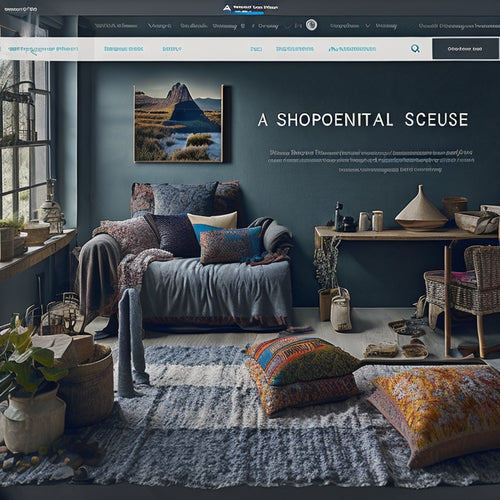
7 Proven Strategies to Retain Valued Customers
Share
To retain your valued customers, you need to focus on building strong relationships with them. Foster personalized experiences by leveraging data and analytics to understand their behaviors and preferences. Reward their loyalty with exclusive offers, and provide proactive customer support to show you care. Encourage feedback and act fast on it to improve their experience. Develop emotional connections by showing empathy and investing in relationships. Create seamless omnichannel experiences and surprise them with thoughtful gifts. By implementing these 7 strategies, you'll not only retain customers but also drive business growth. Now, discover how to put these strategies into action and take your customer retention to the next level.
Key Takeaways
• Foster personalized customer experiences by leveraging data and analytics to understand behaviors, preferences, and pain points.
• Reward loyalty with exclusive offers that show appreciation and encourage repeat business.
• Implement proactive customer support by regularly updating knowledge bases and conducting outreach for complex products or services.
• Encourage feedback and act fast on customer insights to improve experiences and build trust.
• Develop emotional connections with customers by fostering empathy, investing in relationships, and showing care.
Foster Personalized Customer Experiences
By leveraging data and analytics, you can craft tailored interactions that speak directly to your customers' unique needs and preferences, paving the way for lasting relationships and brand loyalty.
This personalized approach not only boosts customer satisfaction but also sets you apart from competitors.
When you take the time to understand your customers' behaviors, preferences, and pain points, you can create experiences that feel tailored to their individual needs.
Reward Loyalty With Exclusive Offers
When you reward loyalty with exclusive offers, you're not only showing appreciation for your customers' repeat business, but also encouraging them to continue choosing you over competitors.
By providing limited-time perks, you create a sense of urgency that motivates customers to take action.
Additionally, offering VIP treatment can make them feel valued and recognized, further solidifying their loyalty to your brand.
Limited Time Perks
Reward your loyal customers with limited-time perks, such as exclusive discounts or early access to new products, to make them feel valued and appreciated. This strategy not only shows your customers that you care, but it also incentivizes them to continue doing business with you.
Here are some ideas to get you started:
-
Flash sales: Offer limited-time discounts on specific products or services to create a sense of urgency and drive sales.
-
Personalized discounts: Provide customized discounts based on individual customers' purchase history or preferences to make them feel seen and heard.
-
Limited time promotions: Create special offers that are only available for a short period, such as '24-hour sales' or 'weekend deals', to create buzz and excitement.
- Special access: Give loyal customers early access to new products, services, or features before they're available to the general public, making them feel like VIPs.
VIP Treatment Inside
You can take your loyalty program to the next level by offering exclusive deals and services that make your valued customers feel like true VIPs. This is where the real magic happens, and you can create a sense of belonging among your most loyal customers.
By providing luxury benefits, such as early access to new products, services, or events, you're showing them that they're part of an elite group.
Offering exclusive access to premium content, events, or experiences can also make them feel special. This can include VIP-only sales, early bird discounts, or even personalized consultations with your team of experts.
The key is to create an air of exclusivity around your loyalty program, making your customers feel like they're part of a select group.
Implement Proactive Customer Support
By anticipating and addressing potential issues before they escalate, businesses can greatly reduce customer complaints and strengthen loyalty. You can achieve this by implementing proactive customer support, which involves continuous improvement and proactive engagement with your customers. This approach enables you to identify and resolve potential problems before they become significant issues.
Here are some strategies to help you implement proactive customer support:
-
Regularly review and update your knowledge base: Guarantee that your customer-facing resources are up-to-date and accurate, providing customers with the information they need to resolve common issues.
-
Conduct proactive outreach: Reach out to customers who've purchased complex products or services, offering guidance and support to ensure they get the most out of their investment.
-
Monitor social media and online reviews: Keep an eye on customer feedback and concerns on social media and online review platforms, addressing any issues promptly and professionally.
- Offer personalized support: Provide tailored support to customers based on their specific needs and preferences, demonstrating that you value and understand their business.
Encourage Feedback and Act Fast
As you work to retain your valued customers, creating a feedback loop that allows them to share their thoughts and concerns is crucial.
By doing so, you'll gain valuable insights into their needs and pain points, enabling you to make targeted improvements that strengthen your relationship.
Hear Their Voice
In today's competitive landscape, customers who feel heard are far more likely to become loyal advocates, making it essential to create a feedback loop that not only encourages their input but also responds promptly to their concerns. You can't assume you know what your customers want; instead, you need to ask them directly. By actively soliciting feedback, you demonstrate a genuine interest in their opinions and experiences, which can greatly boost customer satisfaction.
Here are some ways to hear your customers' voices:
-
Regular surveys: Send out quarterly or bi-annual surveys to gauge customer sentiment and identify areas for improvement.
-
Social media monitoring: Keep an eye on social media conversations about your brand, responding promptly to both praise and criticism.
-
Focus groups: Host in-person or virtual focus groups to gather feedback and opinions from a diverse group of customers.
- Net Promoter Score (NPS) analysis: Track your NPS to measure customer loyalty and identify opportunities to improve feedback analysis.
Act on Insights
You must close the loop with your customers by responding promptly to their feedback, demonstrating that their voices aren't only heard but also valued. This is where the rubber meets the road - you've gathered insights, now it's time to act on them.
Implementing feedback shows customers you're committed to their satisfaction and willing to make changes to improve their experience. Analyzing data helps you identify patterns and trends, allowing you to pinpoint areas that need improvement. By acting on these insights, you can refine your products, services, and overall customer experience.
This, in turn, boosts loyalty, retention, and ultimately, your bottom line. Don't let valuable feedback collect dust - use it to drive meaningful change. Remember, customers are more likely to continue doing business with you if they feel heard and valued.
Resolve Issues Fast
Eighty percent of customers will continue to do business with a company that resolves their issues quickly, making swift issue resolution a critical component of customer retention. You can't afford to let issues linger, as it can lead to frustration, negative reviews, and ultimately, lost business. To guarantee customer satisfaction, you must prioritize speedy resolutions.
Here's how you can achieve this:
-
Designate a response team: Assign a team to handle customer complaints and make sure they're equipped to resolve issues efficiently.
-
Set response time goals: Establish specific timeframes for responding to customer issues, such as within an hour or by the end of the day.
-
Empower your team: Give your response team the authority to make decisions and take actions that resolve issues quickly.
- Follow up: Check in with customers after issues are resolved to make sure they're satisfied and to gather feedback for future improvements.
Develop Emotional Connections With Customers
By fostering genuine empathy and understanding, businesses can create emotional connections with customers that transcend mere transactions and lead to long-term loyalty. You can achieve this by investing in customer relationships, listening to their concerns, and showing that you care.
Emotional bonding is key to building trust, and it's what sets you apart from competitors. When customers feel heard and understood, they're more likely to become loyal advocates, driving growth and revenue.
To develop emotional connections, focus on personalized interactions, tailored to individual needs and preferences. Train your team to be empathetic and responsive, and empower them to make decisions that benefit the customer.
Celebrate milestones and special occasions, and show appreciation for their loyalty. By doing so, you'll create a sense of belonging, making customers feel valued and part of a community.
Create Seamless Omnichannel Experiences
In today's digitally driven marketplace, customers expect to interact with your brand effortlessly across various touchpoints, making it essential to create seamless omnichannel experiences that align with their evolving needs and preferences. You must make certain that every interaction, whether online or offline, is cohesive and consistent. This can be achieved by integrating data from varied sources, providing a unified customer view that enables you to understand their behavior and preferences.
Here are some ways to create seamless omnichannel experiences:
-
Map the customer journey: Understand the various touchpoints your customers interact with and identify areas of improvement.
-
Integrate data from varied sources: Combine online and offline data to get a thorough view of your customers.
-
Provide consistent messaging: Make sure that your brand's message and tone are consistent across all channels.
- Train your staff: Educate your staff on the importance of omnichannel experiences and how to provide them.
Show Appreciation Through Surprise Gifts
You can foster a deeper sense of loyalty and appreciation among your valued customers by surprising them with thoughtful gifts that demonstrate your understanding of their needs and preferences. These customized presents show you're invested in their satisfaction and willing to go the extra mile. By doing so, you'll create an emotional connection that'll keep them coming back to your brand.
Surprise gifts can be as simple as a personalized note or a small product sample. The key is to make it unexpected and relevant to their interests. When you send an unexpected token of appreciation, it grabs their attention and makes them feel valued.
This, in turn, increases the chances of positive word-of-mouth, online reviews, and repeat business. Remember, it's the thought that counts, not the price tag. A well-timed surprise gift can be a powerful retention strategy, especially when combined with exceptional customer service.
Frequently Asked Questions
How Often Should We Interact With Customers to Prevent Feeling Spammy?
Did you know 80% of customers feel brands don't understand their needs? You shouldn't interact with customers too often, or they'll feel spammed. Instead, focus on personalized interactions, respecting their communication frequency preferences to boost customer engagement.
Can We Use Loyalty Programs for B2B Customer Retention Too?
You can leverage loyalty programs for B2B customer retention by offering personalized perks, such as exclusive content or event access, and pairing them with dedicated account management to foster deeper relationships.
What's the Ideal Response Time for Resolving Customer Complaints?
"You're probably thinking, 'Who needs timely resolutions when customers are already complaining?' But, surprisingly, resolving issues within the hour boosts customer satisfaction by 90%! So, aim for a 1-hour response time to turn complaints into loyalty."
Can Customer Feedback Be Used to Improve Our Product Development?
"You can leverage customer feedback to drive product development by conducting surveys, analyzing feedback, and using insights to inform feature enhancements and updates, ensuring your product stays ahead of the curve."
Are Handwritten Notes Effective in Building Emotional Connections?
You're wondering if handwritten notes are a genuine way to forge emotional connections - the answer is yes! They add a personal touch, sparking meaningful customer engagement that sets you apart from impersonal competitors.
Related Posts
-
Can I Add Tiktok to My Shopify Store Without a Tiktok Business Account?
This article explores the possibility of integrating TikTok into a Shopify store without requiring a TikTok Business...
-

Why Optimal Pricing Matters for Online Learning Success
You set your online course prices, but ultimately, they set the tone for your students' perception of value, engageme...
-

Does Shopify Optimize Images
This article examines the extent to which Shopify optimizes images. It explores the benefits of using Shopify's imag...

